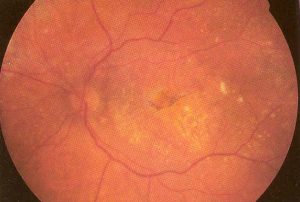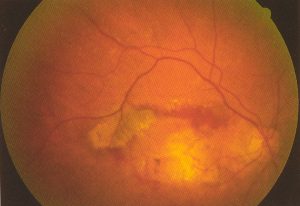Microbiota and eye diseases
- Established scientific data are now available on the correlation between alterations in the composition of the gut microbiota and the pathogenesis of intestinal diseases, including irritable bowel syndrome.
Probably less is known about the correlations between alterations in the microbiota and the onset of certain eye diseases.
The first point to highlight is that this correlation is detectable for eye diseases in which there is an inflammatory component and the specific areas can be summarised as follows:
- Microbiota and age-related macular degeneration
- Microbiota and ocular surface diseases, in particular dry eye
- Microbiota and ocular neurodegenerative diseases, including Glaucoma
Microbiota and AWD
AMD (Age-Related Macular Degeneration) is a chronic degenerative disease, progressive and tending to become bilateral, affecting the maculathe central region of the retina responsible for distinct vision of image details.
If not properly treated, AMD can lead to severe and irreversible visual impairment.
Two forms of AWD are recognised:
 – the atrophic or 'dry' form, which affects about 90% of cases, is characterised by the accumulation below the macula of deposits of yellowish material, the drusenwhich progressively alter the functionality of photoreceptors, the cells responsible for the perception of light stimuli.
– the atrophic or 'dry' form, which affects about 90% of cases, is characterised by the accumulation below the macula of deposits of yellowish material, the drusenwhich progressively alter the functionality of photoreceptors, the cells responsible for the perception of light stimuli.
– the neovascular or 'wet' form"less frequent, but with a more disabling outcome, is characterised by the formation of abnormal small blood vessels below the macula. These vessels, with very fragile walls, can easily ooze fluid, or they can rupture, causing haemorrhages in the retina.
Although the causes of the disease are not yet fully known, some risk factors have certainly been identified. First of all theage (an estimated 8% of the population over the age of 50 is affected by AMD), to which a number of risk factors are combined:
- demographicse.g. ethnicity and gender
- genetics: a number of mutations have been identified that seem to predispose to the onset of the disease.
– environment, such as smoking, alcohol consumption, obesity, low physical activity, prolonged exposure to sunlight, reduced dietary intake of antioxidants.
 In terms of therapy, the big breakthrough for the neovascular form was the introduction of intravitreal treatments with the anti-VEGF drugswhich aim to neutralise the effect of VEGF (Vascular Endothelial Growth Factor), which is involved in the regulation of vessel permeability and growth. Anti-angiogenic drugs are able to stabilise the disease and, in some cases, improve vision in most patients with the wet form, provided they are administered in time.
In terms of therapy, the big breakthrough for the neovascular form was the introduction of intravitreal treatments with the anti-VEGF drugswhich aim to neutralise the effect of VEGF (Vascular Endothelial Growth Factor), which is involved in the regulation of vessel permeability and growth. Anti-angiogenic drugs are able to stabilise the disease and, in some cases, improve vision in most patients with the wet form, provided they are administered in time.
For the atrophic form, there are no drug therapies that can counteract its onset and progression. However, several clinical evidences attest that the nutritional control may constitute a prevention strategy, as certain micronutrients have been shown to have the ability to reduce the risk of disease progression.
Moreover, recent studies have shown that a condition of alteration of the microbiota intestinal (dysbiosis)or a condition of microbial imbalance, can influence the onset and progression of this serious eye disease.
Inflammation and DMLE
Recent studies suggest that the mediators of inflammation play an important role in the pathophysiology of AMD, especially the formation of reactive oxygen species (ROS(Radical Oxygen Species), at high concentrations can damage the retinal pigment epithelium, the layer that absorbs light and nourishes retinal cells, and increase the risk of developing AMD.
The role of the microbiota
Given the role of inflammation and free radicals in the onset of AMD, it was hypothesised that some nutrients with anti-inflammatory and antioxidant action, directly or indirectly, via the gut microbiota may have beneficial effects in preventing AMD.
This hypothesis has aroused a lot of interest from the scientific community, which has started to investigate the effectiveness of prebiotics and probiotics as well as antioxidant-rich foods as a prevention strategy for AMD.
The gut microbiota consists of a number very high number of microorganisms, different microbial species, which is indispensable for the well-being of our organism. With the normal ageing process and especially from the age of 65, the age at which ELD most frequently appears, the intestinal microbiota undergoes changes, losing, for example, the enormous microbial variety. These changes are reflected in a different immune response and appear to be linked to the onset of various metabolic diseases, such as diabetes or age-related diseases, such as AMD.
Which micronutrients are useful in the prevention of AMD and why
A review Italian, published in the journal Nutrients, reviewed some of the most significant studies that analysed the role of the gut microbiota in AMD and highlighted how dietary habits are closely associated with certain diseases.
A 'Western' type diet based on high consumption of dairy products, red meat, sweets and energy drinks was found to be predominantly associated with individuals with AMD.
An 'oriental' diet based on the intake of legumes, rice and low-fat dairy products, on the other hand, has been shown to have a preventive role in the onset of this eye disease.
The substances that have been shown to have the most beneficial effects on ocular health are listed below.
- The vitamin C or ascorbic acid, is mainly found in fruit (citrus fruits, kiwi, strawberries and blackcurrants) or vegetables (cabbage, spinach, tomatoes and potatoes). It has a high antioxidant power, which counteracts free radicals, protecting the eyes against degenerative retinal diseases, glaucoma and taking preventive action against corneal ulcers.
- The vitamin E is a powerful antioxidant, present in large quantities in dried fruits (almonds, peanuts and pine nuts), as well as dried apricots, sunflower seeds, legumes and green leafy vegetables. It is part of a large group of fat-soluble molecules and is able to reduce free radicals and inhibit the spread of ROS.
- The Zinc is a powerful antioxidant that helps the body absorb vitamin A. It is an important trace element involved in various physiological processes, such as the construction of DNA and the correct formation of certain proteins. It is present in eye tissue in high concentrations, particularly in the retina and choroid. Zinc deficiencies affect eye development and the onset of diseases such as cataracts and retinal degenerative diseases and predispose to poor night vision. Zinc is mainly contained in foods such as seafood (especially oysters), eggs, liver, beef and lamb.
- I Carotenoids
Three carotenoids are particularly concentrated in the human macula (the central area of the retina) and have great antioxidant power: lutein, zeaxanthin e meso-zeaxanthin. The first two are found in green leafy vegetables such as spinach, kale, chard and broccoli, as well as in maize, basil, tomatoes, yellow vegetables such as pumpkin, green tea and many other vegetables, while the third is said to be formed in the macula from metabolic transformations of ingested caroteinoids. Therefore, these substances belong to the group of nutritional interventions that can/must be implemented to prevent ageing, macular degeneration and other eye diseases.
In case of deficiencies due to pathological conditions or inadequate nutrition, lutein and zeaxanthine can be supplemented with specially formulated nutraceuticals.
Rinninella E. et al. The Role of Diet, Micronutrients and the Gut Microbiota in Age-Related Macular Degeneration: New Perspectives from the Gut-Retina Axis. Nutrients 2018, 10, 1677- Wong WL, Su X, Li X, et al.
Global prevalence of age-related macular degeneration and disease burden projection for 2020 and 2040: a systematic review and meta-analysis. Lancet Glob Health. 2014 Feb;2(2):e106-16
This article can be downloaded in PDF format
Sheet no. 6 - Microbiota part 2
© Copyright 'l'Oculista italiano
See also:
Microbiota and the Eye - Part I
Dr. Carmelo Chines
Direttore responsabile
